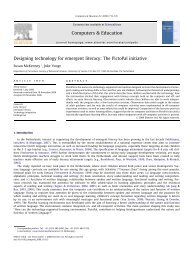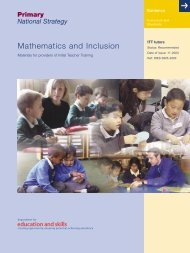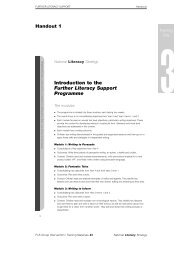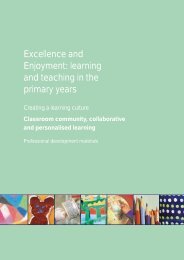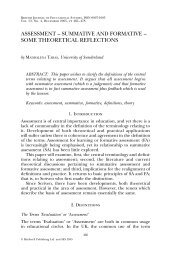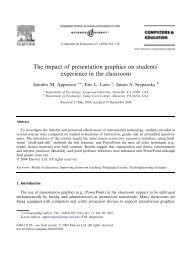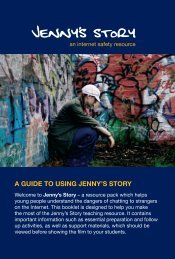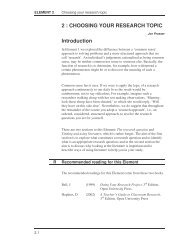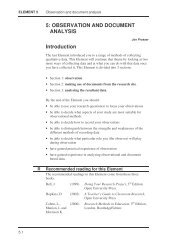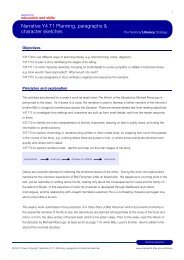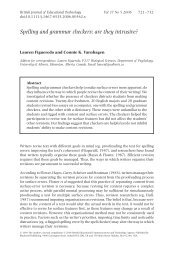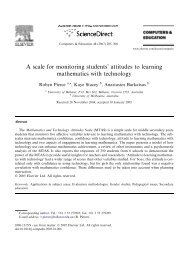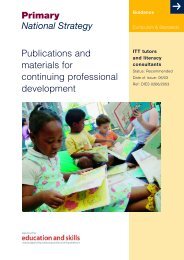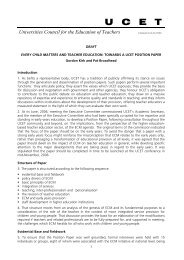Play Y5 T1 Writing playscripts and annotating for performance - PGCE
Play Y5 T1 Writing playscripts and annotating for performance - PGCE
Play Y5 T1 Writing playscripts and annotating for performance - PGCE
You also want an ePaper? Increase the reach of your titles
YUMPU automatically turns print PDFs into web optimized ePapers that Google loves.
department <strong>for</strong>education <strong>and</strong> skills<strong>Play</strong> <strong>Y5</strong> <strong>T1</strong> <strong>Writing</strong> <strong>playscripts</strong> <strong>and</strong><strong>annotating</strong> <strong>for</strong> per<strong>for</strong>manceThe National Literacy Strategy1Objectives<strong>Y5</strong><strong>T1</strong><strong>T1</strong>8 to write own playscript, applying conventions learned from reading, including production notes.<strong>Y5</strong><strong>T1</strong><strong>T1</strong>9 to annotate a section of playscript as a preparation <strong>for</strong> per<strong>for</strong>mance, taking into account pace,movement, gesture <strong>and</strong> delivery of lines <strong>and</strong> the needs of the audience.Principles <strong>and</strong> explanationThe writing of <strong>playscripts</strong> should be taught as part of a longer block on the reading <strong>and</strong> writing of <strong>playscripts</strong>(<strong>Y5</strong><strong>T1</strong>T5,T20). Preferably, this would follow a block focusing on characters (<strong>Y5</strong><strong>T1</strong>T3,<strong>T1</strong>5).Conventions as <strong>for</strong> Year 4 Term 1, plus:Technical terms included, e.g. stage directions, aside, stage right.Characters are clearly distinguished through dialogue, i.e. dialogue well matched toindividual character.Characters, <strong>and</strong> their relationship to each other, developed beyond the stereotype where appropriate.St<strong>and</strong>ard <strong>and</strong> non-st<strong>and</strong>ard English used as appropriate to character, e.g. distinguishing betweenlanguage used by a judge talking in court <strong>and</strong> a judge talking at home.Punctuation used effectively to indicate pausing <strong>and</strong> pacing, e.g. use of commas, ellipsis.Narrative told mainly through dialogue without overuse of narrator figure to move plot <strong>for</strong>ward.CapturingChildren, in pairs, <strong>for</strong>m a ‘still photograph’. This could be an actual photograph or painting, or a situationsuggested by a teacher, e.g. two people looking up into the sky/pointing at the ground, a shopkeeper <strong>and</strong> acustomer, the delivery of a letter.The pairs bring the photograph to life <strong>and</strong> improvise some dialogue.They choose the best three consecutive speeches in their playlet, writing these down on whiteboards,without revealing who the characters are or including any stage directions.The boards are passed to another pair.The scripts are then acted out by the new pair, adding in any actions, interpretation or expression, but noextra words or punctuation.© 2001 Crown Copyright <strong>Play</strong> <strong>Y5</strong> <strong>T1</strong> <strong>Writing</strong> <strong>playscripts</strong> <strong>and</strong> <strong>annotating</strong> <strong>for</strong> per<strong>for</strong>mance www.st<strong>and</strong>ards.dfes.gov.uk/literacy
2DemonstrationTeacher shows own three-line script on flipchart or OHT.Teacher talks through the trans<strong>for</strong>mation of this dialogue into playscript <strong>for</strong>m. Links should be made withsentence level work on proofreading <strong>and</strong> editing (Grammar <strong>for</strong> writing, Unit 34), use of punctuation (Unit 34) thedifferences between spoken <strong>and</strong> written English (Unit 41) <strong>and</strong> the use of present tense <strong>for</strong> stage instructions (Unit37)..© 2001 Crown Copyright <strong>Play</strong> <strong>Y5</strong> <strong>T1</strong> <strong>Writing</strong> <strong>playscripts</strong> <strong>and</strong> <strong>annotating</strong> <strong>for</strong> per<strong>for</strong>mance www.st<strong>and</strong>ards.dfes.gov.uk/literacy
The children draw up a chart showing the differences between a story <strong>and</strong> a playscript, e.g.3StoryCharacters introduced at different points inthe storySetting described in text<strong>Play</strong>scriptCharacters listed at beginning of scriptSetting given by narrator or described instage directionsShared compositionTeacher takes one pair’s ‘three speech’ playlet <strong>and</strong> trans<strong>for</strong>ms this into a script with reference to the chartabove. Children participate by rewriting speeches in playscript <strong>for</strong>m, adding appropriate stage directions,punctuation, etc.Children decide where this scene appears in the play. What might have gone be<strong>for</strong>e, what might happensubsequently?Independent/guided writingWorking in pairs, children produce <strong>playscripts</strong> based on their original drama activity. These can then be exp<strong>and</strong>edinto longer scripts <strong>and</strong> subsequently published <strong>for</strong> per<strong>for</strong>mance or recording.© 2001 Crown Copyright <strong>Play</strong> <strong>Y5</strong> <strong>T1</strong> <strong>Writing</strong> <strong>playscripts</strong> <strong>and</strong> <strong>annotating</strong> <strong>for</strong> per<strong>for</strong>mance www.st<strong>and</strong>ards.dfes.gov.uk/literacy



